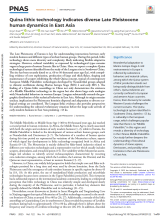The Late Pleistocene of Eurasia is key for understanding interactions between early modern humans and different types of archaic human groups. During this period, lithic technology shows more diversity and complexity, likely indicating flexible adaptative strategies. However, cultural variability as expressed by technological types remains vague in large parts of eastern Eurasia, like in China. Here, we report a complete Quina technological system identified from the study of the Longtan site in Southwest China. The site has been securely dated to ca. 60 to 50 thousand years ago (ka), with compelling evidence of core exploitation, production of large and thick flakes, shaping and maintenance of scrapers exhibiting the whole Quina concept, typical of contemporary European Middle Paleolithic technologies developed by Neanderthal groups adapted to climatic oscillations during Marine Isotope Stage (MIS) 4 and early MIS 3. The finding of a Quina lithic assemblage in China not only demonstrates the existence of a Middle Paleolithic technology in the region but also shows large-scale analogies with Neanderthal behaviors in western Europe. Longtan substantially extends the geographic distribution of this technical behavior in East Asia. Although its origin remains unclear, implications for Pleistocene hominin dispersal and adaptation to diverse ecological settings are considered. The Longtan lithic evidence also provides perspectives for understanding the cultural evolutionary situation before the large-scale arrivals of early modern humans in East Asia predating ~45 ka
Quina lithic technology indicates diverse Late Pleistocene human dynamics in East Asia
Ruan, Q., H. Li, P. Xiao, B. Li, H. Monod, A. Sumner, K. Zhao, J. Liu, Z. Jia, C. Wang, A. Fan, M. Moncel, B. Marwick, M. Peresani, Y. Wang, F. Chen, & D. Delpiano (2025) Quina lithic technology indicates diverse Late Pleistocene human dynamics in East Asia Proceedings of the National Academy of Science 122 (14) e2418029122
View PDF
(3.91 MB)
